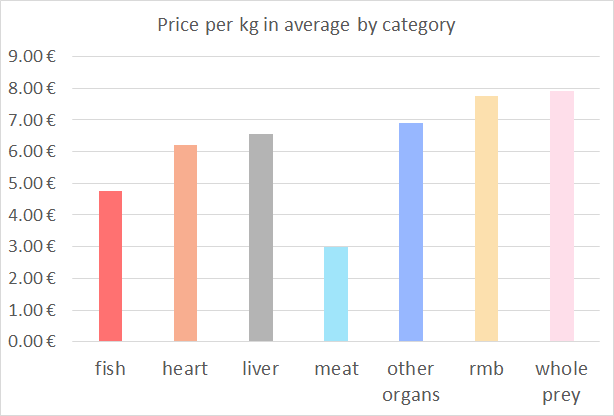Is raw feeding expensive?
One of the most asked questions about raw feeding is: “how much does it cost?”. Most of the time, people assume that it is expensive.
The answer to this question is not simple, and it depends mainly on where you live and your motivation. Usually, though, raw food is actually less expensive than premium “cat food”.
In this article, I compiled a list of everything I bought for Néline in the past 5 months, and I will present you some results as an example. As I already had some food in my freezer when I started and some at the end of the 5 months, the results are not extremely precise, but they are good enough to provide some insight.
5 months of raw feeding
Results
In 5 months I spent a total of 125.29€ for 25.87 kg of food, yielding an average of 4.84€ per kg.
This translates into 25.06€ a month to feed a cat of 4.7kg.
It is important to note that during these 5 months I didn’t have a big freezer: I only had one drawer and a half dedicated to Néline’s food. Because of that, I never bought raw meat in bulk, which could have had reduced the costs significantly.
Everything I bought comes from my supermarket, except for the day-old chicks that I got from a pet store which sells them as reptile food.
Finally, as during these 5 months I only had one cat (and, therefore, the total expense was not that much), I didn’t really make an active effort to find extremely good plans at my supermarket.
Analysis
I made an analysis of the data I collected during these 5 months, and you can download the file with the results here: What I bought for 5 months of raw feeding.
Breakdown of the amount of meat by category
You can see that the breakdown of what I bought follow quite closely the prey model ratio.
In terms of price, I mainly saved money on the meat category, which I can find at a quite cheap price. Raw meaty bones and whole prey is what cost the most for me.
Breakdown of the amount of meat by category
Finally, as you can see from the plot, I had quite some diversity during these 5 months of raw feeding, with 11 different sources of proteins. You can count 3 types of liver, 5 types of other organs, 3 type of hearts and 3 types of fish. I sometimes spend more money to buy “rare” proteins such as lamb.
Breakdown of the amount of meat by category
Tips to reduce your costs
If you have enough space, consider buying a big freezer (if you don’t have one already). Having more storage allows you to buy meat online in bulk, or to buy larger quantities at the store when there are discounts.
Track the discounts and meat with short expirations dates at your supermarket.
Order on online stores specialized in raw food. You can often find groups on Facebook where there are people living in the same area willing to order large quantities of meat and share the shipping fees (which can be very high).
Ask your butcher if they can give you meat scraps. For example chicken feet, meat which is one day after the expiration date…
Look if there is any slaughterhouse or farmer from which you can buy your meat directly, at a discounted price.
To sum up, the cost of raw feeding depends on where you live (meat prices will vary), your storage capacity, your motivation/possibility to find good plans, and the weight of your animal. A Maine Coon will eat more than a munchkin, for example.
Raw feeding is usually not more expensive than common “cat food”.
Finally, I would like to conclude with saying that for me, raw feeding is not just a matter of price. Even if it were more expensive than “cat food”, I would still raw feed my cats, as their health doesn’t have a price.


